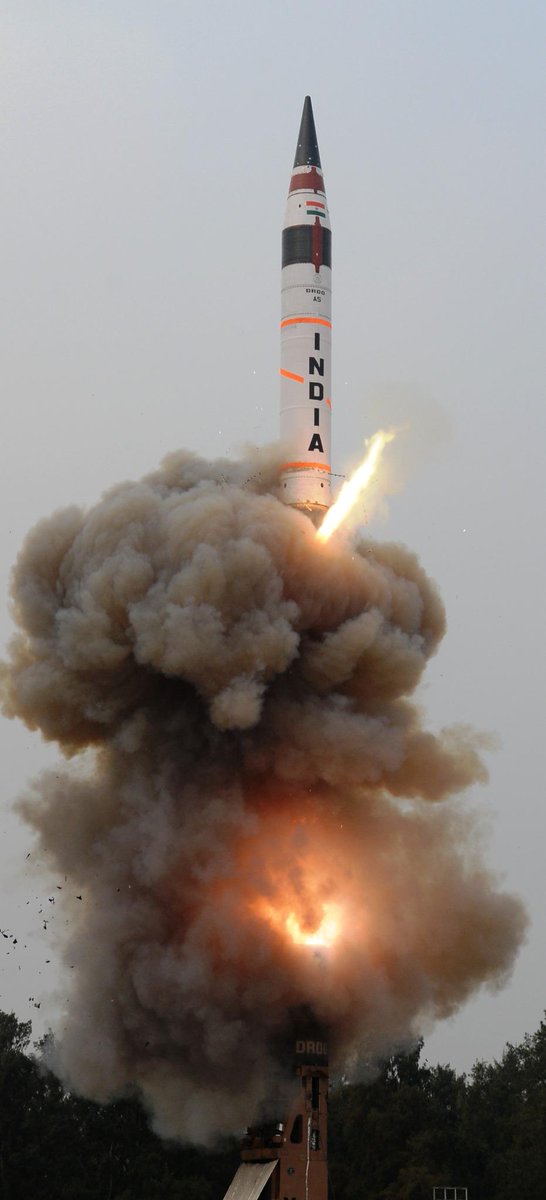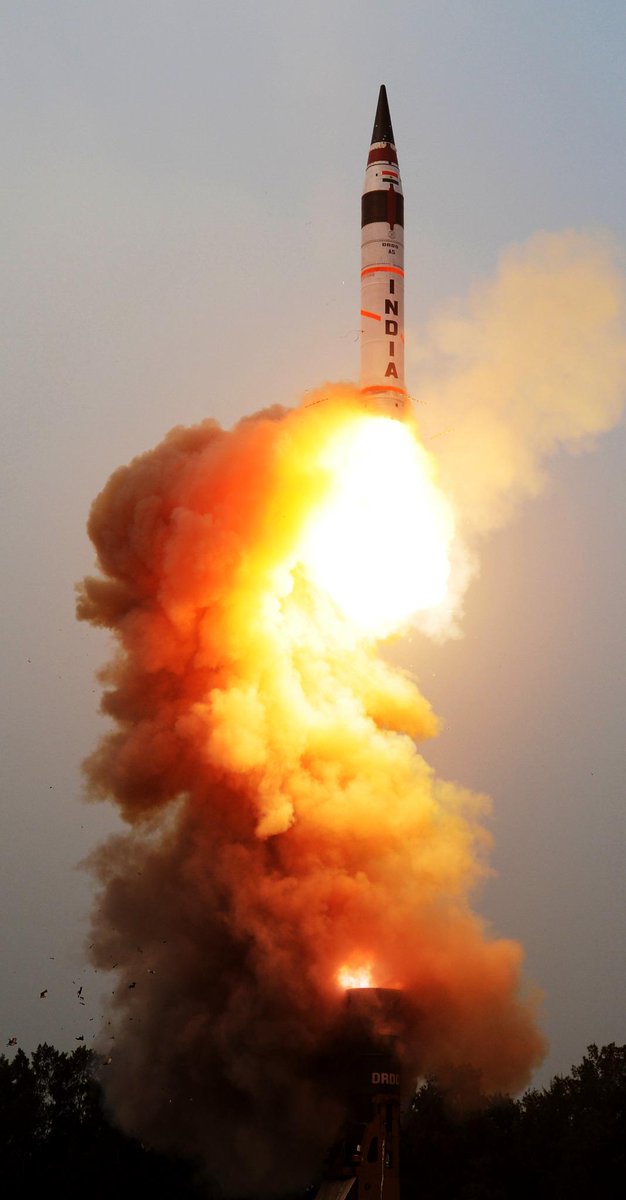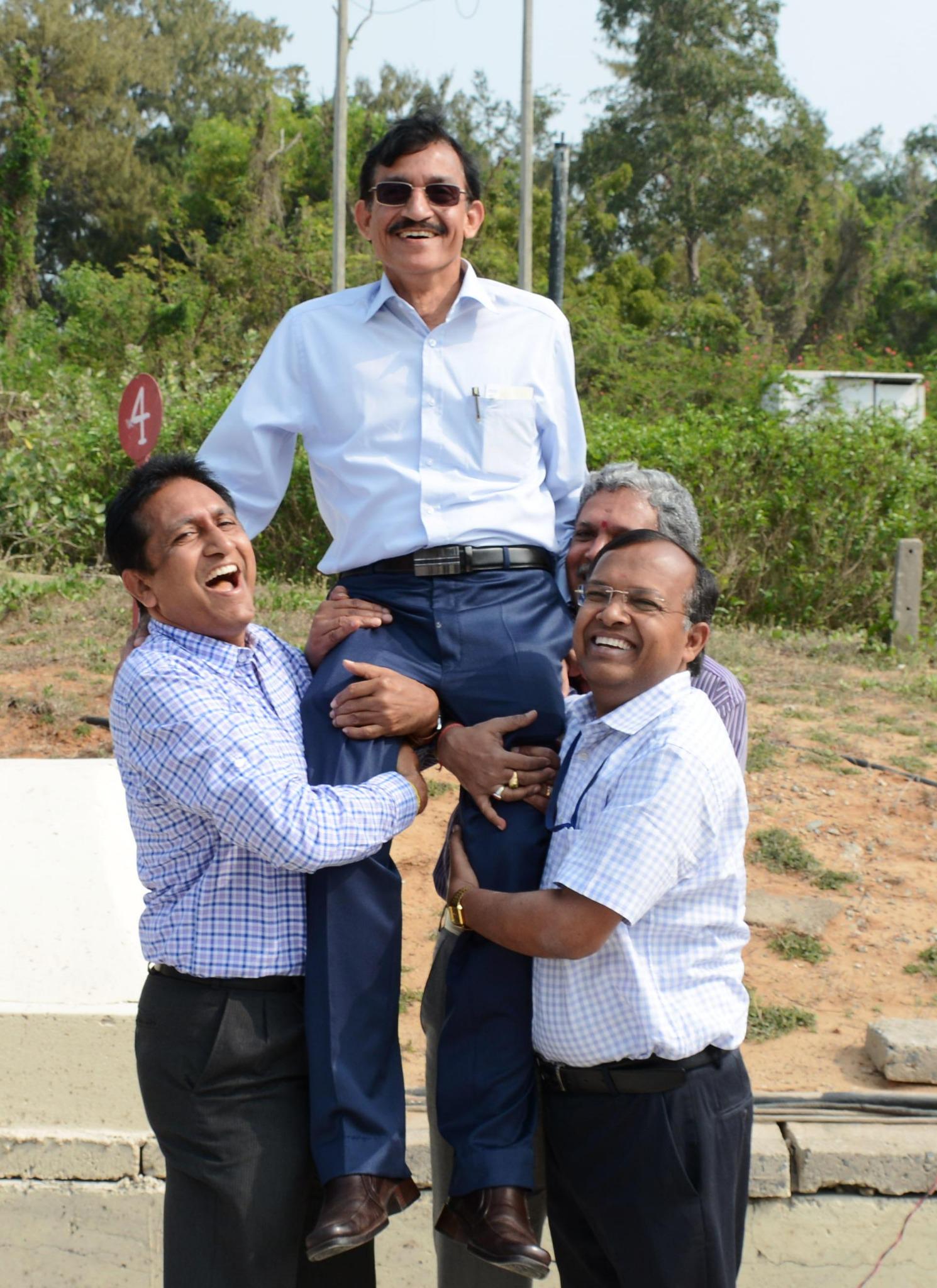





FantasticRoyG wrote:
AoA!!!!!!!!!!!!!!!!!!!!!!!!!!!!!!!
Saurav Jha @SJha1618 22m22 minutes ago Fort Tondiarpet, Tamil Nadu
Apogee for this morning's Agni-V launch was around 600 kms. What does that tell you?
TIGER HINDU @ROHIT_4_right 21m21 minutes ago
@SJha1618 that the chinese were correct about the missile range n that we r bluffing ☺
Aviral Kapoor @AviralKapoor_ 18m18 minutes ago
@SJha1618 isnt that enough to send something in orbit? please explain.
Saurav Jha @SJha1618 17m17 minutes ago
@AviralKapoor_ It's actually lower than the apogee this class of vehicle can attain. It means that it was a depressed trajectory launch.
Agni-V in any case is also meant to give India operationally responsive space launch capability with microsatellite launch on demand.
proud to say my class topper is involved in development of this strategic asset for our great nation.RoyG wrote:
AoA!!!!!!!!!!!!!!!!!!!!!!!!!!!!!!!
India’s ICBM Agni 5 was successfully test fired from a canister today 31 Jan 2015 at 0809 hrs.
Normally, to get a full range, the useful RoT is that the apogee is set to 20% of the range. Agni IV reaches about 800 Kms, for example.prasannasimha wrote:Can anyone calculate probable max distance using peak altitude of 500Kms and preclvious data
India launches 5,000-km range Agni-5 missile successfully
Ajai Shukla | New Delhi April 20, 2012 Last Updated at 00:58 IST
The tension sharpened at the launch area at Wheeler Island on the Odisha coast this morning as the massive, 50-tonne, 17.5-metre-high Agni-5 missile was elevated into the vertical launch position, and the pre-launch checks began. The previous evening, exactly at this stage, lightning and thunder in the skies above had led to the launch being put off till morning.
At 8.07 am the countdown went... 5… 4… 3… 2… 1… Now… and a giant ball of fire leapt out as the missile’s first stage ignited. As the Agni-5 rose smoothly off the launch pad, scientists checked off the health of its systems on the public address system, their voices calm, measured, almost surreal, given the tension amongst the viewers. After 90 seconds, the first stage burnt out and separated. The missile was travelling at exactly the speed it should have been. Then, on schedule, the second stage burnt out and separated, an all-new composite stage that had performed exquisitely. By now there was already the sense that this would be a perfect test.
Within minutes, the missile was in space, streaking southwards for 2,000 km until it crossed the equator. Then, it hurtled along for another 3,000-km, re-entering the atmosphere over the Tropic of Capricorn and splashing down between the southern tip of Africa and Australia. From launch to splash-down, just 20 minutes had elapsed.
“Indian naval vessels tracked the missile all along its course, including at the terminal stage. The accuracy of the missile was exactly as expected,” said the DRDO’s spokesperson.
For V K Saraswat, the Defence R&D Organisation chief, after a lifetime of working in the DRDO’s ballistic missile programme, this was the sweetest of moments.
“Any launch is tense, even after testing a hundred missiles; and this was the first launch of the Agni-5,” Saraswat told Business Standard soon after the test. “Over the last three-four days, the team had gone through the complete launch process, with each activity and system being put through our scanners: the propulsion system, navigation system, everything. By yesterday, I was completely confident of a successful launch.”
At the launch pad with Saraswat were Avinash Chander, the DRDO’s chief controller of missiles, a man of few words and big achievements; V G Sekaran, the laconic, wry-humoured boss of Advanced Systems Laboratory, the home of the Akash programme; Tessy Thomas, the self-effacing “missile woman”, who handled the Agni-4 project; and Dr Gupta, the project director for this test.
“For us, the Agni-5 success is the culmination of 30 years of work that began in earnest in 1983,” said Dr Saraswat.
Defence Minister A K Antony congratulated the team for “the immaculate success” of the Agni-5, hailing the efforts of “numerous unsung scientists of DRDO who have worked relentlessly years together to bring the nation to this threshold”.
In fact, the success of the Agni-5 was almost a foregone conclusion. Last November, several challenging new technologies that this missile incorporates were validated in an unannounced launch of the surprise Agni-4 missile.
That new 3,500-km range missile successfully tested a new composite rocket motor, made of lightweight composite materials instead of the heavier “maraging steel” that earlier rocket motors were fabricated from. The other brand-new technologies that the Agni-4 tested included: a highly accurate “ring-laser gyroscope based inertial navigation system (RINS)”; a “micro-navigation system (MINGS)”; and a powerful new onboard computer. By testing all these technologies in the Agni-4, the DRDO minimised the technology risks of Thursday’s Agni-5 test.
The DRDO chief told Business Standard the Agni-5 was not just a long-range rocket. “This missile incorporates unique technologies that will allow us to have multiple variants. We can achieve short ranges, higher ranges… all with the same missile,” he said.
Although the DRDO calls the Agni-5 an intercontinental ballistic missile (ICBM), its range of 5,000 km puts it — by most conventional measures —in the class of intermediate range ballistic missiles (IRBMs), which have ranges of 3,000-5,500 km. The Agni-5’s range is carefully calibrated; it can reach targets anywhere except for America and Australia. This would allow it to strike all of India’s potential adversaries, even as friendly capitals in Western Europe and the US stay out of range. DRDO sources say that, in case of need, the Agni-5 could easily be ramped up into an intercontinental ballistic missile (ICBM), with a range of more than 5,500 km.
For now, more testing lies ahead, says the DRDO chief. “We will have two more test launches of the Agni-5, and then productionise it for induction into field service with the Strategic Forces Command. We will also start working on different variants of the Agni-5, including MIRVs (multiple independently targetable re-entry vehicles), anti-satellite systems, and on making the Agni-5 capable of launching military satellites on demand,” says Saraswat.
A distinctive feature of the Agni-5 is its “canisterisation”. Immediately after its manufacture, the missile is hermetically sealed into an airtight canister. Mounted on a flatbed truck, the missile can be easily transported to a launch site; and fired quickly by hydraulically raising the canister into the vertical firing position. The canister is made of maraging steel, allowing it to absorb the enormous stresses of firing, when 300-400 tonnes of thrust is generated to eject the 50-ton missile. The hermetically sealed atmosphere inside the canister allows the missile to be stored safely for years.
The DRDO claims the Agni-5’s advanced navigation system would permit the use of smaller nuclear weapons. Speaking earlier to Business Standard, Avinash Chander said, “Megaton warheads were used when accuracies were low. Now we talk of (accuracy of) a few hundred metres. That allows a smaller warhead, perhaps 150-250 kilotons, to cause substantial damage. We don’t want to cause wanton damage (with unnecessarily large warheads).”
I have a fleeting suspicion that MaRV was tested along with the wooden round.Marking another technological milestone in the country’s missile programme, the maiden canister-based trial of India’s most potent strategic missile, Agni-V was successfully carried out for its full range of more than 5,000 km from the Wheeler Island, off the Odisha coast on Saturday.
A DRDO missile technologist who was associated with the launch described it as a grand success and said it was a perfect launch. Another missile technologist said it would be the footprint for future configuration of Agni-V.
The missile sealed in a canister and mounted on a TATRA track was launched in its final deliverable configuration at 8.10 am. As soon as the auto-launch command was given, the 17-metre-long Agni-V lifted off majestically leaving a trail of orange flames and leapt into a sunny sky after the gas generator at the bottom of the canister gave it a forceful thrust.
Within moments after its ejection and upon reaching a height of around 30 metres, the first stage got ignited and separated. As it reached a height of more than 500 km and began descending rapidly, the subsequent two stages also got decoupled with clockwork precision and the missile’s nose cone carrying the dummy payload withstood searing temperatures of more than 3,000 degrees Celsius and impacted near the pre-designated point in the Indian Ocean after a flight of about 20 minutes.
The 17-metre-long, thee-stage solid-fuelled missile, developed indigenously by the Defence Research and Development Organisation (DRDO), is expected to boost India’s nuclear deterrence capability along with other strategic missiles in Agni series. Agni-V is capable of delivering a 1.1 nuclear warhead over a distance of 5,000 km and the range of missile can cover most parts of China and Europe.
A network of radars, electro-optical tracking systems and telemetry stations, besides two ships stationed near the impact point monitored the health of the missile during its flight and recorded the terminal event.
This was the third successful flight test of the Inter- Continental Ballistic Missile and the first canister trial.
The missile is expected to be inducted into service in a year after a few more canister trials.
Scientific Advisor to Defence Minister Avinash Chander, the architect of Agni-V, who will be relinquishing office on Saturday, was present along with other top DRDO missile technologists, including Director-General of Missiles and Strategic Systems, Dr.V.G.Sekaran and Research Centre Imarat Director, G. Satheesh Reddy.
yes . the cap either hinges open or is totally thrown off to the ground before the tube goes vertical(topolM)A Sharma wrote:silly question
Is the canister closed before launch?
No it is not a hot launch or else you would have an exit plume from the sides .See the launches of larger ICBM's on youtube and they do have a lot of fumes coming out of the canister and ejecting out of a "cap" etc etc.Singha wrote:it almost seems like instead of a gas generator at the bottom of tube there is a tiny solid fuel booster that hot launches it out of the tube and then moves to the side using brahmos angry bull snorting technique.
this is unlike any other iCBM for ex the topol-M which rise clean and cold out of the tube.
https://www.youtube.com/watch?v=gzSr2HThmmI
the K4 due to underwater launch will need the cold gas thruster though.
congrats! had to sleep off losing the earlier posts. now, i saw the launch in .25 slow motion on jutoob, the angry bull snort event happens just when only the rear edge leaves the canister. the pressurized hold maintains till the missile completely ejects out.dinesha wrote:Launch video.
https://m.youtube.com/watch?v=KnykStFQS ... e=youtu.be
I think they have not shown any splash down video in the recent past as it would allow others to get an idea of the CEP and fuze and expected size of the warhead.ramana wrote:Great job.
Would like more data on critical parameters and splash down video.
https://www.facebook.com/agni5/posts/979805405380677OFFICIAL STATEMENT: India’s ICBM Agni 5 was successfully test fired from a canister today 31 Jan 2015 at 0809 hrs. It was a historic moment when for the first time in India, an ICBM about 17m long and weighing over 50 ton majestically rose from the confines of its canister. At the predetermined moment, having risen to about 20 meters height, it’s first stage motor ignited lifting Agni 5 into the sky. The flight continued on its predetermined path during which the second, all composite light weight motor, followed by the third, innovatively designed conical all composite rocket motor propelled the missile into space taking it to a height of more than 600 km. The missile, after reaching peak of its trajectory turned towards earth to continue its journey towards the intended target with a speed now increasing due to the attraction of earth’s gravitational pull and its path precisely directed by the advanced on-board computer and inertial navigation system. As the missile entered earth’s atmosphere, the atmospheric air rubbing the skin of the missile during the re-entry phase raised the temperature to beyond 4000 degree Celsius. However, the indigenously designed and developed carbon-carbon composite heat shield continued to burn sacrificially protecting in the process the payload, maintaining the inside temperature below 50 degree Celsius. Finally, commanded by the on-board computer with a support of highly accurate ring laser gyro based inertial navigation system, the most modern micro inertial navigation system (MINS), fully digital control system and advanced compact avionics, the missile hit the designated target point accurately, meeting all mission objectives.
Ajit Doval, National Security Advisor congratulated Dr Avinash Chander and the Mission team for the successful launch, over a tele-conversation. Congratulating team Agni, Air Chief Marshal Anup Raha, PVSM, AVSM, VM, Chairman Chiefs of staff committee and Chief of Air Staff, who had witnessed the entire launch operations from the control room called it a great achievement. Lt Gen Amit Sharma AVSM, VSM, Cdr in Chief Strategic Forces Command, also present on the occasion, called it a fantastic achievement.
Addressing the gathering and project team, a happy and satisfied Dr Avinash Chander, Secretary DDR&D, SA to RM and DG DRDO said, “This is a momentous occasion. It is India’s first ever ICBM launch from a canister and is a giant leap in country’s deterrence capability”. He termed it a copy book launch with entire command network functioning in loop. Dr Avinash Chander congratulated the entire DRDO community for the tremendous efforts put in by them in making the country self reliant in the area of long range missile systems. He thanked them for demonstrating such a great success on the last day of his work in DRDO. Dr Avinash said, “I cherished every moment of my service in DRDO and I thank you all for the relentless support given to me all through. I am leaving with a great satisfaction of equipping the country with such advanced missiles. I wish the entire DRDO community a great future”.
Earlier, announcing the success of the mission, Dr VG Sekaran, Mission Director, Prog. Dir. Agni and DG Missiles and Strategic Systems said “All mission objectives have been achieved, down range ships have confirmed final splashdown, the mission is a great success and it is a momentous occasion”. A jubilant Dr Rajesh Kr Gupta, Project Director Agni5, described the success as “historic achievement; a dream fulfilled”.
The Ships located in midrange and at the target point tracked the Vehicle and witnessed the final event. All the radars and electro-optical systems along the path monitored all the parameters of the Missile and displayed in real time. The earlier two flights of Agni 5, fully successful were in open configuration and had already proved the missile. Today’s launch from a canister integrated with a mobile sophisticated launcher, was in its deliverable configuration that enables launch of the missile with a very short preparation time as compared to an open launch. It also has advantages of higher reliability, longer shelf life, less maintenance and enhanced mobility.
Dr G Satish Reddy, DS & Director, RCI, Dr Manas K Mandal, DS & DG LS, Dr GS Malik, CCR&D HR, Dr Tessy Thomas, Director ASL, Dr PS Subramaniam DS & PGDCA and Dir ADA, Dr Manmohan Singh Dir VRDE, Shri Manjit Singh, Director TBRL and Dr SK Patel, Director Quality Reliability and Safety were among other senior DRDO scientists present on the occasion.
https://scontent-a-dfw.xx.fbcdn.net/hph ... e=556F2E70
DRDO officials hoisting Dr Avinash Chander after today's successful Agni 5 missile launch. Its his last day at work.
"Mission accomplished. I am a satisfied man.": Dr Avinash Chander
https://www.facebook.com/agni5/posts/979992772028607:0
Possession of hydrogen bombs ‘essential’ for India - Russian analysts
India will be capable of mastering all three ways of delivering nuclear warheads. That is via aircrafts, ballistic missiles and nuclear submarines. “The world is heading towards an enhancement of military tensions and conflicts. Leveraging its nuclear potential, India wants to ensure its own security,” Sivkov says. “It is quite a legitimate aspiration of any country and an objective necessity of India. China is in possession of a thermonuclear bomb. The appearance of the hydrogen bomb in India could cause an explosion of indignation in the Chinese diplomacy and cause it to further develop its nuclear weapons. But China is on the way of almost openly being in conflict with the United States. It will continue building up its forces, including nuclear, not to compete with India, but with the United States.”
So far, China has not responded to findings of the report by IHS Jane’s. Pakistan has commented on it very guardedly. A representative of the ruling Pakistani Muslim League, said: “We do not want an arms race. This does not go in favour of both the countries.” In India itself, the report's findings are not being commented at all.
gotcha.. also confirmed from the coupling seen outside:Singha wrote:Saik it is three stage. The big cone on top is both conical third stage and room for one big warhead.
With a6 we should see the traditional ogival nose section and deployment of aerospike and aeroplate mashallah
New third stage will be cylinder and more powerful for mirv payload.
